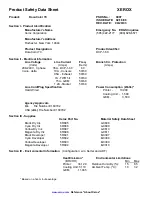
2
2-3
Office applications
Office applications
The Color Server must receive PostScript instructions to print an image or a
document. Many applications do not create these PostScript instructions, relying on
the printer driver to create them. Included in this category are most word processing,
spreadsheet, and presentation graphics applications. These applications use Windows
Graphics Device Interface (GDI) to display and print when running Windows, and
Apple QuickDraw to display and print when running Mac OS. We refer to these GDI
and QuickDraw applications as “office applications.”
All office applications handle color similarly, using the same RGB color model used for
the color monitor. Most office applications allow you to choose colors from a palette of
preselected colors; some allow you to add new colors to the palette using a color picker.
Although some applications allow you to specify color using the CMY, HSL, and HSV
color models, these applications always send RGB color data to the Color Server. (An
exception to this is a CMYK EPS file placed in the document, which is sent as
CMYK data.)
Consider the following when working with color in office applications:
• The range of colors that can be displayed in RGB on your monitor is much larger
than the range of colors that can be printed on your printer. When you print the
document, out-of-gamut RGB colors are mapped to the colors your printer can
produce.
• Office applications send only RGB data to the Color Server. You control the
rendering style of the color conversion with your selection of a CRD.
Each CRD uses a different color rendering style and, therefore, has a different way of
mapping unprintable colors to the color gamut of your printer. For more
information on color rendering styles, see the
Summary of Contents for Fiery color server
Page 1: ...Color Server FIERY COLOR REFERENCE ...
Page 2: ......
Page 6: ......
Page 16: ......
Page 36: ......
Page 100: ...AA 8 Desktop Color Primer ...
Page 120: ......
















































